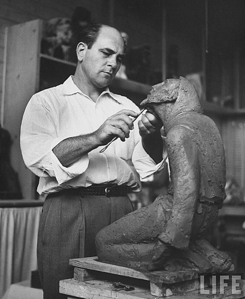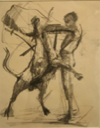Charles Umlauf
American, (1911–1994)
Charles Umlauf, artist, sculptor and educator, was born Karl Julius Umlauf on July 17, 1911, on a farm near South Haven, Michigan. He was the sixth of eight children born to Christian Heinrich and Charlotte (Derouet) Umlauf. His parents were poor German immigrants who moved frequently seeking work. They eventually settled down in Chicago when Umlauf was eight years old.
Umlauf was interested in carving and forming figures from an early age. Despite the tough economic times, he remained focused on his love of art. He began taking formal training in a Saturday program for youth offered by the Art Institute of Chicago. Umlauf graduated from Austin High School in Chicago and immediately began study at the Institute. In 1932, after three years of study, he worked as an assistant under Viola Norman at the Chicago School of Sculpture. During this time the young artist created a pair of sculptures that were exhibited at the World's Fair held in Chicago in 1933. He returned to school in 1934 and studied for another two years. His major early influences were artists like Rodin and Donatello. Over his lengthy career Umlauf exhibited a broad range of artistic expression, including realistic, expressionist and abstract works.
Umlauf married Angeline Allen, another Institute student, in 1937. They had six children. He worked in the Chicago area, and was hired by a WPA Federal Art Project to create sculpture for public buildings (the works were completed during a period from 1939 to 1941). These works included Spirit of Communication, located at the Morton Post Office in Morton, Illinois, Protection, and Mosaic Pool, at the Cook County Hospital in Chicago, Paulding Industries, at the Paulding Post Office in Paulding, Illinois, and Boy With Sea Forms, located at the Lane Technical High School in Chicago.
In 1941 Umlauf joined the new art department of the University of Texas as instructor in sculpture, and moved his family to Austin. He served on the faculty for forty years. Umlauf was considered a tough but caring teacher, and received a Teaching Excellence Award. He was known for a crushing handshake, which was often accompanied by a wide smile. In the early years of the art department student clay works were fired in a kiln that could reach a temperature of 3,000 degrees. The kiln was located in a wooden barracks building used during World War II. Umlauf would climb up into attic with a fire extinguisher to ensure that the building would not burn down as the student works were fired.
Umlauf continued creating both small and monumental works of art throughout his educational career. He published two books on his work through the University of Texas Press-Charles Umlauf, Sculptor in 1967 and The Sculpture and Drawing of Charles Umlauf in 1980. He retired as professor emeritus in 1981. In 1960 Umlauf began personally supervising the casting of his works at metal foundries in Italy. He continued this practice until 1991. Umlauf was awarded a Guggenheim Fellowship and also a Ford Foundation Grant. He was honored by the Houston Art League as "Texas Artist of the Year" in 1985, and declared "Alcalde" by the City of San Antonio in 1993.
Works by Umlauf can be found throughout the United States, in private collections, churches, and museums. Umlauf is considered to have the most works of any sculptor displayed in public places in Texas. Within the state his work can be found at the Houston Museum of Fine Arts, the Witte Museum in San Antonio, and the Umlauf Sculpture Gardens in Austin. Nationally-renowned art museums such as the New York Metropolitan Museum of Art and the Smithsonian also have his work in their collections.
In 1944 the Umlauf's purchased property in what was then an undeveloped part of Austin just above Barton Springs, and created his studio and a garden. Umlauf and his wife Angeline donated their home and studio, along with 168 pieces of art and sculpture, to the city of Austin in 1985. In 1991 a museum was built with private money. A nonprofit organization runs the Umlauf Sculpture Garden and Museum, which features more than 130 of his works, and is located on Robert E. Lee Road in Austin, Texas. Umlauf died on November 19, 1994.
American, (1911–1994)
Charles Umlauf, artist, sculptor and educator, was born Karl Julius Umlauf on July 17, 1911, on a farm near South Haven, Michigan. He was the sixth of eight children born to Christian Heinrich and Charlotte (Derouet) Umlauf. His parents were poor German immigrants who moved frequently seeking work. They eventually settled down in Chicago when Umlauf was eight years old.
Umlauf was interested in carving and forming figures from an early age. Despite the tough economic times, he remained focused on his love of art. He began taking formal training in a Saturday program for youth offered by the Art Institute of Chicago. Umlauf graduated from Austin High School in Chicago and immediately began study at the Institute. In 1932, after three years of study, he worked as an assistant under Viola Norman at the Chicago School of Sculpture. During this time the young artist created a pair of sculptures that were exhibited at the World's Fair held in Chicago in 1933. He returned to school in 1934 and studied for another two years. His major early influences were artists like Rodin and Donatello. Over his lengthy career Umlauf exhibited a broad range of artistic expression, including realistic, expressionist and abstract works.
Umlauf married Angeline Allen, another Institute student, in 1937. They had six children. He worked in the Chicago area, and was hired by a WPA Federal Art Project to create sculpture for public buildings (the works were completed during a period from 1939 to 1941). These works included Spirit of Communication, located at the Morton Post Office in Morton, Illinois, Protection, and Mosaic Pool, at the Cook County Hospital in Chicago, Paulding Industries, at the Paulding Post Office in Paulding, Illinois, and Boy With Sea Forms, located at the Lane Technical High School in Chicago.
In 1941 Umlauf joined the new art department of the University of Texas as instructor in sculpture, and moved his family to Austin. He served on the faculty for forty years. Umlauf was considered a tough but caring teacher, and received a Teaching Excellence Award. He was known for a crushing handshake, which was often accompanied by a wide smile. In the early years of the art department student clay works were fired in a kiln that could reach a temperature of 3,000 degrees. The kiln was located in a wooden barracks building used during World War II. Umlauf would climb up into attic with a fire extinguisher to ensure that the building would not burn down as the student works were fired.
Umlauf continued creating both small and monumental works of art throughout his educational career. He published two books on his work through the University of Texas Press-Charles Umlauf, Sculptor in 1967 and The Sculpture and Drawing of Charles Umlauf in 1980. He retired as professor emeritus in 1981. In 1960 Umlauf began personally supervising the casting of his works at metal foundries in Italy. He continued this practice until 1991. Umlauf was awarded a Guggenheim Fellowship and also a Ford Foundation Grant. He was honored by the Houston Art League as "Texas Artist of the Year" in 1985, and declared "Alcalde" by the City of San Antonio in 1993.
Works by Umlauf can be found throughout the United States, in private collections, churches, and museums. Umlauf is considered to have the most works of any sculptor displayed in public places in Texas. Within the state his work can be found at the Houston Museum of Fine Arts, the Witte Museum in San Antonio, and the Umlauf Sculpture Gardens in Austin. Nationally-renowned art museums such as the New York Metropolitan Museum of Art and the Smithsonian also have his work in their collections.
In 1944 the Umlauf's purchased property in what was then an undeveloped part of Austin just above Barton Springs, and created his studio and a garden. Umlauf and his wife Angeline donated their home and studio, along with 168 pieces of art and sculpture, to the city of Austin in 1985. In 1991 a museum was built with private money. A nonprofit organization runs the Umlauf Sculpture Garden and Museum, which features more than 130 of his works, and is located on Robert E. Lee Road in Austin, Texas. Umlauf died on November 19, 1994.
Artist Objects
Bullfight 1981.202
Goddess in Repose 1981.271



